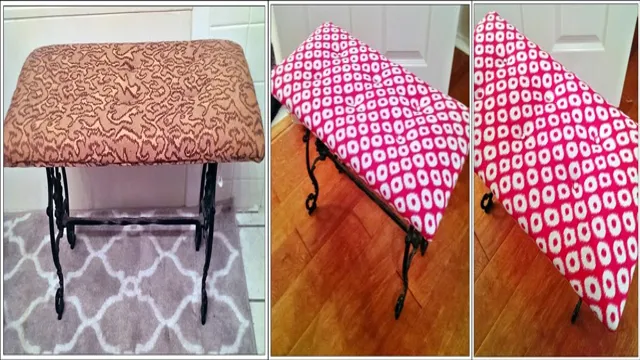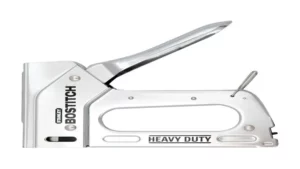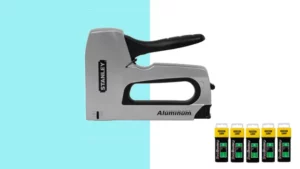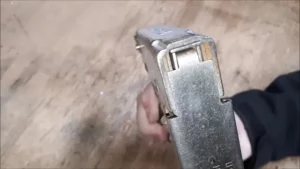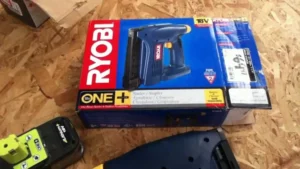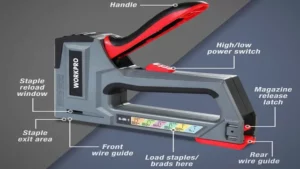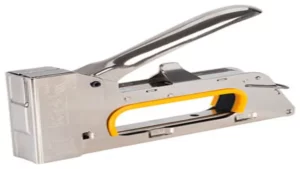Revamping old furniture is a great opportunity to give them new life and personality. And one piece that stands out for its versatility and timeless appeal is the Ottoman. Whether you have a worn-out Ottoman laying around or scored a hidden gem from a thrift store, updating it to fit your style and needs is both gratifying and cost-effective.
And one way to do it is by using a staple gun. Yes, a staple gun! It’s not complicated, and with a few steps, you can give your old Ottoman a fresh, modern look that will make it the centerpiece of any room. In this blog, we’ll guide you through the process of recovering an Ottoman with a staple gun, showcasing expert tips and tricks to make the project fun and easy.
So, roll up your sleeves, grab your staple gun, and let’s bring new life to your old Ottoman in no time!
Gathering Materials
If you’re looking to recover an ottoman with a staple gun, you’ll first need to gather all the necessary materials. Luckily, this process does not require many items and can be accomplished easily. Firstly, you’ll need a staple gun – preferably an electric one as it will save you time and effort.
Next, you’ll need fabric that’s large enough to cover the entire ottoman – make sure to choose a fabric that’s durable and easy to clean. You’ll also need a pair of fabric scissors for cutting the fabric to size. Lastly, you’ll need a ruler or tape measure to ensure you get precise measurements.
Once you have all these items, you’re ready to start recovering your ottoman. But don’t worry, the process is simple and with the right tools and these easy-to-follow steps, you’ll have your ottoman looking brand new in no time!
Measuring the Ottoman
When measuring the Ottoman, the process starts by gathering materials that will be used for this task. This involves collecting tools that can accurately measure the dimensions of the Ottoman. Common tools that are used include measuring tapes, rulers, and calipers, among others.
Once the tools have been collected, the next step is to determine the dimensions to be measured. The length, width, and height are the primary dimensions that need to be measured. It is essential to measure accurately to ensure that the Ottoman fits perfectly into the intended space.
When gathering materials, it is also essential to consider the materials used to construct the Ottoman. The type of fabric or leather used to make the Ottoman will determine how it can be measured. Therefore, it is important to take into account the stretch and texture of the materials to ensure the most accurate measurements possible.
By gathering all the necessary materials, one can start the process of measuring the Ottoman with ease.
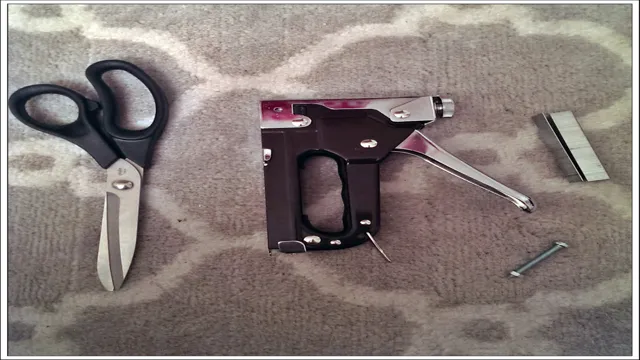
Choosing the Fabric
When it comes to choosing the perfect fabric for your project, the process can seem overwhelming. There are a variety of fabrics to choose from, each with their own specific attributes and qualities. To begin, consider the purpose of the item you are creating.
Is it meant to be durable and long-lasting, or is it primarily for show? If durability is key, consider selecting a tightly woven fabric like canvas or denim. For a softer, more decorative piece, a flowy fabric like satin or chiffon might be a better fit. Another factor to consider is the color and pattern of the fabric.
Do you want a bold, eye-catching pattern or a more muted, solid color? Ultimately, the key is to select a fabric that fits your vision for the final product while also meeting any practical requirements you may have.
Purchasing a Staple Gun
When it comes to purchasing a staple gun, it’s important to gather the right materials. Of course, the staple gun itself is a given, but don’t forget to think about the types of staples you’ll need as well. Will you be using the staple gun for heavy-duty projects that require thicker staples? Or are you using it for lighter projects that only need thinner staples? It’s important to consider the strength and size of the staples you’ll be using to ensure they work with your staple gun and are appropriate for the job at hand.
Additionally, make sure you have a good supply of staples on hand so you don’t run out mid-project. By gathering the right materials ahead of time, you’ll be well-prepared to take on any stapling task that comes your way.
Preparing the Ottoman
One of the best ways to give a new look to your old and worn-out ottoman is by recovering it with a staple gun. Before you start, make sure that you have all the necessary supplies like fabric, batting, and a staple gun. The first step is to remove the old fabric from the ottoman by cutting along the seams.
Once you have removed the old fabric, check if the padding or batting needs to be replaced. After this, you can start measuring and cutting the new fabric to the appropriate size, leaving extra fabric around the ottoman’s edges. Before you staple the new fabric to the ottoman, make sure that it is properly aligned and smooth, then staple it in place, starting at the center of each side and pulling the fabric tight as you staple towards the corners.
When all sides are stapled in place, trim off any extra fabric, and then give your newly recovered ottoman the finishing touches it deserves. With a little time and effort, you can have a stylish and updated piece of furniture for your home.
Removing the Old Fabric
When preparing to reupholster an ottoman, the first step is to remove the old fabric. This can be a bit of a daunting task, but with patience and a bit of elbow grease, it’s certainly achievable. First, gather the necessary tools, such as a pair of pliers and a staple remover.
Then, carefully flip the ottoman over and begin removing the staples or tacks that are holding the fabric in place. This can be a bit of a tedious process, but it’s important to remove all the staples or tacks so that the old fabric can be completely removed. Once all the staples or tacks have been removed, carefully pull the old fabric off the ottoman.
Be sure to take note of any areas that may need extra padding or repairs before moving on to the next step. By taking the time to properly prepare the ottoman, you’ll be able to ensure that the new fabric looks great and is long-lasting.
Sanding and Painting the Frame (Optional)
Preparing the Ottoman for sanding and painting is an important step in giving it a fresh new look. Firstly, you’ll need to remove any hardware or fabric if there is any present. Then, clean the surface of the Ottoman with a damp cloth and let it dry completely.
Once it’s all dry, sand the entire surface of the Ottoman lightly. This step is necessary to remove any existing paint, stain, or rough surface from the Ottoman. After sanding, use a tack cloth to remove all the dust particles from the surface.
Now, you can apply a primer coat to the Ottoman and let it dry for a few hours. Once the primer is dry, you can apply a coat of paint according to your liking. A good tip would be to use spray paint as it’s easy to use and dries quickly.
Remember to apply thin and even coats of paint and let it dry between each layer. By following these steps, you can give your Ottoman a brand new look and enjoy it for years to come!
Recovering the Ottoman
Looking for a budget-friendly way to give your old ottoman a fresh new look? Look no further than a trusty staple gun! Recovering an ottoman with a staple gun is a simple and easy process that can be done by anyone, even those without any experience in upholstery. First, remove the old fabric and padding carefully, making sure not to damage the wooden frame. Then, measure and cut your new fabric to size, leaving enough excess to fold over the edges of the ottoman.
Use a staple gun to attach the fabric to the bottom of the ottoman, pulling it taut as you go. Repeat the process on each side of the ottoman, making sure to create neat and tidy corners. Finally, trim any excess fabric and add a layer of batting or foam before attaching a final layer of fabric with your staple gun.
With a little effort and creativity, you can recover your ottoman and give it a whole new lease on life!
Cutting and Securing the Fabric
When it comes to recovering an ottoman, cutting and securing the fabric is crucial. It’s essential to use a sharp pair of fabric scissors to ensure clean cuts and avoid fraying. Before cutting, you need to measure and mark the fabric correctly to get the perfect fit.
Once you’ve cut the fabric, secure it to the ottoman using a staple gun or upholstery tacks. It’s best to start at the center of each side and work your way out, pulling the fabric tight to avoid wrinkles or lumps. Remember to fold and tuck in the corners neatly for a professional finish.
With the right techniques and careful attention to detail, your ottoman will be looking brand new in no time. So don’t hesitate to give it a go and recover it to match your personal style.
Stapling the Fabric onto the Ottoman
After removing the old fabric from your ottoman, recovering it can be a fun and easy DIY project. One of the final steps is to staple the new fabric onto the ottoman. Begin by centering the fabric over the ottoman and staple it in the center of one side.
Then, pull the fabric taut and staple it to the opposite side. Continue this process for the remaining two sides, and be sure to check and adjust the placement of the fabric as needed. Take care to fold the corners neatly and staple them securely.
Once you’re finished, trim any excess fabric and admire your handiwork! With a little bit of time and effort, you can give your ottoman a whole new look and breathe new life into your living space.
Finishing Touches
Recovering an ottoman with a staple gun can be a great way to give an old piece of furniture new life. First, remove any old fabric from the ottoman and prepare it for the new cover. Then, measure and cut your new fabric, leaving enough excess to wrap around the edges and tuck underneath.
Use a staple gun to secure the fabric to the ottoman, starting at one side and working your way around. Be sure to pull the fabric tight as you staple to avoid any wrinkles or sagging. Once you’ve covered the entire ottoman, trim any excess fabric and add any finishing touches such as tufting or decorative trim.
With just a few supplies and some patience, you can easily give your ottoman a stylish, updated look.
Conclusion
In conclusion, recovering an ottoman with a staple gun is a simple and cost-effective way to give new life to your furniture. It may seem daunting at first, but with a little patience and creativity, you can transform your tired old ottoman into a stylish new centerpiece for your living space. And who knows, you might even discover a newfound love for DIY projects that will save you money and impress your guests.
So grab your staple gun and get ready to unleash your inner upholsterer!
FAQs
What materials do I need to recover an ottoman with a staple gun?
You will need fabric, foam padding, a staple gun, staples, and scissors.
Can I recover an ottoman without a staple gun?
While a staple gun is the easiest and most efficient way to recover an ottoman, you can also use a hammer and nails or fabric glue.
How much fabric do I need to recover an ottoman?
The amount of fabric you need will depend on the size of your ottoman. Measure the length, width, and height and add a few inches to each measurement to ensure enough fabric.
Do I need to remove the old fabric before recovering an ottoman?
Yes, it is recommended to remove the old fabric to ensure a smooth and professional-looking finish.
How can I ensure the fabric on my recovered ottoman stays in place?
Use plenty of staples around the edges and corners of the ottoman to keep the fabric taut and in place.
Can I recover an ottoman with leather or vinyl fabric?
Yes, you can recover an ottoman with leather or vinyl fabric. Use a heavy-duty staple gun with longer staples to ensure the fabric stays in place.
How long does it take to recover an ottoman with a staple gun?
The time it takes to recover an ottoman with a staple gun will depend on the size and complexity of the ottoman, but it can take anywhere from a few hours to a full day.
